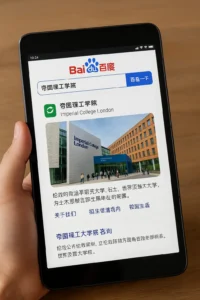The number of Chinese students applying to UK universities keeps rising — but so do their expectations. Learn how accurate translation, cultural localization, and smart communication can help British universities win their trust, boost engagement, and stand out in an increasingly competitive education market.
8 Must-Have Website Localization Features for the Chinese Market (2025)
Why British Universities Must Compete Smarter for Chinese Students

The UK remains a top destination for Chinese students because of its academic reputation, short degree duration, and global career advantages.
According to the British Council (2024), over 150,000 Chinese students are currently enrolled in UK higher education.
Many are drawn by universities such as Oxford, Cambridge, and Imperial College London, where research excellence and international exposure offer lifelong prestige. For Chinese families, studying in Britain represents not only education but also cultural capital — a sign of success and upward mobility.
So, the key question becomes:
How can UK universities make their message resonate with Chinese students?
The answer lies in accurate translation and smart localization — not just word-for-word conversion, but cultural adaptation that builds trust and engagement from the first click.
UK Universities Actively Recruiting Chinese Students
Many UK universities are actively recruiting Chinese students, seeing China as a key source of global talent and tuition revenue.
- University of Manchester – nearly half of its international students come from China, making it one of the top destinations for Chinese applicants.
- University of Bath – highlights China as its largest non-UK student group and offers dedicated scholarships and partnerships with Chinese institutions.
- University College London (UCL) and University of Edinburgh – both maintain long-term collaborations with Chinese universities and run extensive recruitment programs through Chinese education fairs.
Together with visa-friendly policies, joint degree programs, and strong alumni networks in China, these universities are competing to attract high-achieving Chinese students to study in the UK.
How UK Universities Can Attract More International Students — Especially from China
To attract more Chinese and international students, British universities must emphasize three elements: clear communication, digital presence in China, and long-term relationship building. Students rely heavily on peer reviews and social media; therefore, partnerships with Chinese influencers, alumni storytelling, and localized WeChat or RED content can amplify trust and visibility. Universities that present authentic student experiences, transparent costs, and support systems tend to outperform those relying solely on traditional recruitment fairs.
Why Translation Matters More Than Ever
1. Translation Builds Trust
Chinese parents often make final decisions about overseas study. When your materials are in clear, culturally appropriate Chinese, they perceive your institution as more professional and student-focused. Poor or literal translations make them question whether the same lack of care exists elsewhere — in academics or student support.
2. It Reduces Drop-Offs and Confusion
From visa documents to housing details, accurate translation minimizes misunderstandings that can lead to frustration or abandoned applications.
Imagine translating “conditional offer” literally as “有条件的提议” instead of “有条件录取通知书” — it sounds non-official and confusing. One phrase can change a family’s perception of your credibility.
3. It Boosts Visibility on Chinese Platforms
Most Chinese students research via Baidu, WeChat, and Xiaohongshu (RED) — not Google. A properly localized website with Mandarin keywords, meta descriptions, and structured data can dramatically improve your SEO visibility in China.
4. It Creates Emotional Connection
Translation isn’t just linguistic; it’s emotional. The right tone helps Chinese readers feel that your university understands their culture, ambitions, and challenges — from career hopes to family expectations.
The Current Reality: A Growing but Changing Market
According to Times Higher Education (2024), applications from China are likely to rise further if the UK maintains political and economic stability. However, growth may slow down due to cost-of-living pressures and new competition from Canada, Singapore, and European universities.
Meanwhile, a HEPI report found that many Chinese students struggle with cultural adaptation, social integration, and navigating the British education system. (The Guardian, December 2024) even urged UK universities to “provide better support for students from China,” including improved communication and bilingual materials.
In short: the opportunity is big — but only for those who are ready to adapt.
Where UK Universities Often Go Wrong in Chinese Communication
Even leading universities occasionally stumble in their Chinese communication. Here are some frequent pitfalls:
- Machine translation with no review – producing awkward, literal text full of mismatched terms.
- Copy-pasting English slogans – phrases like “Apply Now to Secure Your Spot” become stiff and unnatural (“立即申请保障名额”).
- Unlocalized visuals or tone – overly casual humor or idioms that don’t translate culturally.
- Incomplete localization – Chinese pages link back to English forms or untranslated documents.
- Missing Chinese SEO – no Baidu-optimized keywords, poor metadata, or untranslated alt-text on images.
Each of these mistakes erodes trust — and trust is the main currency in cross-border education.
Best Practices: How to Get It Right

1. Start with Key Web Pages
Translate and localize:
- Homepage and About pages
- Admissions and scholarship information
- Student life, accommodation, and career support sections
- FAQs and application instructions
Use localized headings (H2/H3) and include Chinese keywords naturally. Add structured data to improve visibility on Chinese search engines.
2. Tell Real Stories in Chinese
Feature testimonials and success stories from Chinese alumni and current students.
- Translate their quotes accurately but naturally.
- Add bilingual subtitles to videos or WeChat posts.
- Emphasize values like family pride, diligence, and professional achievement — themes that resonate deeply with Chinese audiences.
3. Localize Documents, Not Just Pages
Offer bilingual PDFs or guides for:
- Application steps
- Visa requirements
- Pre-arrival checklists
- Accommodation contracts
Avoid word-for-word legalese — make sure translated documents are clear, usable, and culturally accurate.
4. Engage Through WeChat
WeChat is not optional — it’s essential.
- Create a verified WeChat Official Account.
- Publish Chinese articles introducing your programs, campus life, and success stories.
- Integrate mini-programs that allow users to request information, register for webinars, or even begin applications.
- Offer live chat in Mandarin during peak seasons.
5. Quality Control Matters
Behind every accurate translation should be a structured process:
- Human translators with education expertise.
- CAT tools and bilingual termbases to ensure consistency.
- Peer review by native Chinese linguists.
- Regular updates after curriculum or policy changes.
Case Studies: UK Universities Leading by Example

University of Nottingham Ningbo China
The University of Nottingham was among the first to open a full Sino-foreign campus in Ningbo. Nearly all academic and administrative content is bilingual. Their localized approach has built a reputation for transparency and accessibility, both online and on campus.
University of Surrey & DUFE (Dalian)
The Surrey-DUFE International Institute offers dual-degree programs with localized teaching materials, bilingual marketing, and active collaboration with Chinese media platforms. This partnership reinforces Surrey’s visibility and trust in the Chinese market.
King’s College London
King’s developed a WeChat mini-program offering instant access to course info, application timelines, and student events — fully localized. The program significantly improved inquiry rates from mainland China.
The University of Manchester
Manchester redesigned its Chinese landing page with SEO optimization for Baidu and RED (Xiaohongshu). After translating key student-life sections and integrating Mandarin videos, traffic from Chinese IPs increased by over 35% within six months.
Common Lesson Learned
All these universities invested in consistent, human-checked translation. None relied solely on AI or free tools. That’s what separates credible communication from “Google Translate marketing.”
Measuring Translation Success
To ensure your translation and localization efforts pay off, track the following:
- Traffic sources: Chinese IPs, Baidu search queries, WeChat referral data
- Engagement metrics: bounce rate, time on page, clicks on Chinese content
- Conversion rate: form submissions, webinar registrations, or inquiries
- Feedback: surveys or focus groups with Chinese students
- Brand mentions: on WeChat, Zhihu, or Douban education communities
Combine these data points to evaluate whether your translated content is driving both visibility and trust.
Beyond Language: Cultural Sensitivity
Successful localization goes beyond grammar. For Chinese audiences:
- Avoid humor or sarcasm that may not translate.
- Use respectful tone and collective language (“we,” “our community”).
- Emphasize stability, reputation, and future employability.
- Show care for safety, mental health, and student well-being — key parental concerns.
When language, visuals, and message all align, your university stops feeling “foreign” and starts feeling “familiar.”
The Technology Advantage

Modern localization isn’t slow or expensive — when done smartly:
- Use Translation Memory to avoid re-translating identical phrases.
- Maintain a centralized term base for academic and administrative terms.
- Combine human translators with AI-assisted quality checks.
- Set up periodic audits with student volunteers to test clarity and tone.
This approach ensures consistency across departments and future updates.
In international education, translation is not an afterthought — it’s your university’s first handshake with potential students.
A perfectly written Chinese page signals care, credibility, and competence.
A clumsy or half-translated one closes the door before the conversation even begins.
For British universities aiming to remain global leaders, accurate translation and localization are now essential competitive tools. They don’t just attract applicants — they build lifelong advocates.
If your university wants to attract more Chinese students and build long-term trust, start by reviewing your Chinese materials. Are they accurate? Culturally appropriate? SEO-optimized?
At AZ-Loc, our team specializes in helping universities and education providers localize academic, marketing, and administrative content for Chinese audiences — ensuring accuracy, fluency, and genuine engagement.
Contact us today to make your Chinese communication as world-class as your education.
